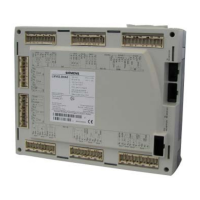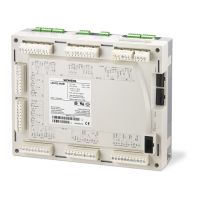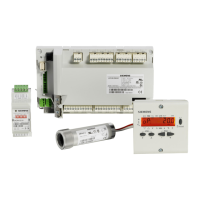Do you have a question about the Siemens LMV52.200B2 and is the answer not in the manual?
Critical warnings to prevent injury, damage, or explosion during operation.
Guidelines for correct installation and mounting of the LMV5 unit.
Notes on electrical wiring, cable routing, and compliance with standards.
Important notes for adjusting fuel-air ratio control and parameter settings.
Overview of the LMV5 system components and their functions.
Characteristics of burner control inputs and outputs, including flame detectors.
Details on available flame detection methods and their connection.
Description of various digital inputs for safety and control functions.
Description of safety-related and non-safety-related digital outputs.
Detailed overview of the burner control sequence and its phases.
Functionality ensuring gas valves are not opened and ignition is off when a leak is detected.
Mapping of actuator functions to specific addresses for LMV5 variants.
Procedures for enabling or disabling actuators based on application and fuel type.
How program phases are controlled by the burner and advance with fuel-air ratio control.
Defining and checking safety time for fuel-air ratio control deviations.
Overview of the integrated PID boiler controller and its operation modes.
Using internal, external, or BACS load controllers with the LMV5.
Defining burner operation as manual, automatic, or off.
Load controller operating modes: Modulating or Multistage.
Automatic modulating operation for gas and manual setting for oil.
Manually adjusting PID parameters for proportional band, integral action time, and derivative action time.
Automatic adjustment of PID parameters based on system characteristics.
Configuration for 2-stage or 3-stage burners, reducing switching frequency.
Adjusting and switching between two setpoints (W1, W2) for temperature or load control.
Safety-related function to limit temperature and prevent overheating.
Protection against thermal shock during cold starts by stepwise increasing output.
Pin assignments for CAN, COM1 (PC), and COM2 (BACS) interfaces.
Display formats for lockout, error history, and safety phase messages.
Process for addressing actuators and assigning their functions within the system.
Parameterizing curves for fuel-air ratio control, including gas and oil settings.
Automatic self-setting of PID controller parameters for optimal load control.
Performing loss-of-flame and safety limit thermostat tests.
Initial setup steps including burner identification and fuel train selection.
Configuring the load controller with different operating modes and sensor inputs.
Defining control parameters via standard sets, manual setting, or automatic adaptation.
Protection against thermal shock during cold starts by stepwise increasing output.
Terminal descriptions, symbols, safety class, I/O, and electrical ratings for AC 230 V.
Terminal descriptions, symbols, safety class, I/O, and electrical ratings for AC 230 V.
Terminal descriptions, symbols, safety class, I/O, and electrical ratings for AC 230 V.
Terminal descriptions, symbols, safety class, I/O, and electrical ratings for AC 230 V.
Terminal descriptions, symbols, safety class, I/O, and electrical ratings for AC 230 V.
Terminal descriptions, symbols, safety class, I/O, and electrical ratings for AC 230 V.
Terminal descriptions for temperature/pressure controllers and current output.
Guidelines for proper mounting, protection degree, and ambient temperature.
Rules for wiring, separation of sections, and cable specifications.
Information on powering the LMV5 unit using the AGG5.2 transformer.
Documenting fuel-air ratio control and O2 trim control parameters.
Steps for configuring the VSD based on motor type and ramps.
Automatic process for standardizing motor speed to 0-100% range.
How O2 trim control reduces combustion air based on control deviation.
Operating modes for O2 trim controller and O2 alarm functions.
Connecting the PLL52 module for residual oxygen control with LMV52.
Step-by-step guide for setting fuel-air ratio control and O2 alarm.
Procedure for setting O2 trim control parameters and ensuring correct fuel-air ratio.
How FGR reduces NOx by feeding flue gas back to the combustion chamber.
Parameters defining FGR operating modes and their functions.
Setting FARC with FGR, including modes without or with temperature compensation.
Critical warnings to prevent injury, damage, or explosion during operation.
Guidelines for correct installation and mounting of the LMV5 unit.
Notes on electrical wiring, cable routing, and compliance with standards.
Important notes for adjusting fuel-air ratio control and parameter settings.
Overview of the LMV5 system components and their functions.
Characteristics of burner control inputs and outputs, including flame detectors.
Details on available flame detection methods and their connection.
Description of various digital inputs for safety and control functions.
Description of safety-related and non-safety-related digital outputs.
Detailed overview of the burner control sequence and its phases.
Functionality ensuring gas valves are not opened and ignition is off when a leak is detected.
Mapping of actuator functions to specific addresses for LMV5 variants.
Procedures for enabling or disabling actuators based on application and fuel type.
How program phases are controlled by the burner and advance with fuel-air ratio control.
Defining and checking safety time for fuel-air ratio control deviations.
Overview of the integrated PID boiler controller and its operation modes.
Using internal, external, or BACS load controllers with the LMV5.
Defining burner operation as manual, automatic, or off.
Load controller operating modes: Modulating or Multistage.
Automatic modulating operation for gas and manual setting for oil.
Manually adjusting PID parameters for proportional band, integral action time, and derivative action time.
Automatic adjustment of PID parameters based on system characteristics.
Configuration for 2-stage or 3-stage burners, reducing switching frequency.
Adjusting and switching between two setpoints (W1, W2) for temperature or load control.
Safety-related function to limit temperature and prevent overheating.
Protection against thermal shock during cold starts by stepwise increasing output.
Pin assignments for CAN, COM1 (PC), and COM2 (BACS) interfaces.
Display formats for lockout, error history, and safety phase messages.
Process for addressing actuators and assigning their functions within the system.
Parameterizing curves for fuel-air ratio control, including gas and oil settings.
Automatic self-setting of PID controller parameters for optimal load control.
Performing loss-of-flame and safety limit thermostat tests.
Initial setup steps including burner identification and fuel train selection.
Configuring the load controller with different operating modes and sensor inputs.
Defining control parameters via standard sets, manual setting, or automatic adaptation.
Protection against thermal shock during cold starts by stepwise increasing output.
Terminal descriptions, symbols, safety class, I/O, and electrical ratings for AC 230 V.
Terminal descriptions, symbols, safety class, I/O, and electrical ratings for AC 230 V.
Terminal descriptions, symbols, safety class, I/O, and electrical ratings for AC 230 V.
Terminal descriptions, symbols, safety class, I/O, and electrical ratings for AC 230 V.
Terminal descriptions, symbols, safety class, I/O, and electrical ratings for AC 230 V.
Terminal descriptions, symbols, safety class, I/O, and electrical ratings for AC 230 V.
Terminal descriptions for temperature/pressure controllers and current output.
Guidelines for proper mounting, protection degree, and ambient temperature.
Rules for wiring, separation of sections, and cable specifications.
Information on powering the LMV5 unit using the AGG5.2 transformer.
Documenting fuel-air ratio control and O2 trim control parameters.
Steps for configuring the VSD based on motor type and ramps.
Automatic process for standardizing motor speed to 0-100% range.
How O2 trim control reduces combustion air based on control deviation.
Operating modes for O2 trim controller and O2 alarm functions.
Connecting the PLL52 module for residual oxygen control with LMV52.
Step-by-step guide for setting fuel-air ratio control and O2 alarm.
Procedure for setting O2 trim control parameters and ensuring correct fuel-air ratio.
How FGR reduces NOx by feeding flue gas back to the combustion chamber.
Parameters defining FGR operating modes and their functions.
Setting FARC with FGR, including modes without or with temperature compensation.
| Type | Control Unit |
|---|---|
| Series | LMV5 |
| Model | LMV52.200B2 |
| Frequency | 50/60 Hz |
| Protection Class | IP40 |
| Supply Voltage | 220...240 VAC |
| Power Consumption | 20 VA |
| Application | Single-burner control for gas and oil burners |
| Flame Safeguard | Integrated |
| Communication | Modbus, BACnet |
| Ambient Temperature | -20 to +60 °C |












